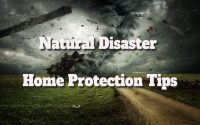Bug Out Bag Checklist
Bug Out Bag Checklist
Emergency planning is something we rarely have to consider. It is something no one likes to think about. Nobody wants to be in a situation where their life is in danger!
What happens if you are put in such a situation? A natural disaster is approaching, and your home is unsafe.
You may need to leave your current location. A bug-out bag is especially useful in this situation.
An emergency bag like this might help you live and move fast if you are in immediate danger.
In this article, we’ve built a bug-out bag checklist and discussed the importance of this type of equipment.
What is a bug-out bag?
A bug-out bag goes by many different names. It could also be known as:
Pack an emergency bag.
72-hour bag.
Go bag.
Evacuation bag.
Survival bag.
It is a single emergency survival pack—a “jack of all trades” kit that may be employed in various situations.
Where did the term come from?
The word “bug out” originates from the United States Military and the Korean War. Soldiers were given the signal to leave if their defensive position was overrun.
They would then flee to safety, assuming a new position. Since then, the word has been adopted by several military formations. Many military bodies use the term “bail-out” as an alternative.
What is the purpose of a bug-out bag?
A bug-out bag’s primary aim is to allow you to swiftly flee your immediate location in the case of an emergency or disaster.
With a bug-out pack checklist and equipped bag, you can evacuate in as little time as possible. As a result, your chances of being injured or caught up in the upcoming event are significantly reduced.
But what kind of disasters do we mean? We’ve provided a couple of examples below for your convenience:
Hurricanes.
Landslides.
Earthquakes.
Tsunamis.
Flooding.
Severe blizzards.
War.
Essentially, any natural calamity and human-caused conflict. A bug-out bag checklist, for example, may be required if you live in an area prone to storms or tornadoes.
Alternatively, you could live in an area of open conflict with the potential to escalate.
Whatever the reason, a bug-out bag allows you to react fast. You can save significant time obtaining necessities. Everything you need is already in your backpack.
You may easily take it up, strap it on, and get it out securely. This is why creating a bug-out bag checklist and planning supplies is critical.
Bug Out Bag Checklist: The Essentials
So, what items should you include in your bug-out pack checklist? We divided our checklist into categories to make it easier to digest:
Hydration.
Food supply.
Clothing.
Shelter.
Heating.
First aid.
Hygiene.
Tools.
Lighting.
Communications.
Travel equipment.
Hydration
Water is the most vital item in a bug-out bag. Humans cannot live without water for more than 72 hours. At a minimum, your bug-out bag checklist should include 3 litres of drinking water (enough for 72 hours), a water bottle, and a water filter.
We have a guide to the best water filters here. These excellent devices allow you to filter stream and lake water for drinking if your primary water supply runs out.
Food Supplies
Next, we have food supplies. Although the human body can do without food for about three weeks, having a source of food can help you stay energised and moving.
The main thing to remember here is that you must pack non-perishable food. If you fill your bug-out bag with perishable goods, they will spoil quickly, and you may run out of food altogether.
Ideally, you want enough food to last for at least 72 hours. Energy bars are an excellent food item to have.
They are compact, portable, and non-perishable, providing the nutrition you need to keep going. There are also several dehydrated meals available.
Summit to Eat, for example, produces a line of dehydrated meals that require just water to be prepared. These are fantastic if you have extra water to spare.
Clothing
Clothing is another important category. You will need a variety of attire to fit the weather circumstances. The best suggestion we can offer is to work in layers. Layering your clothes allows you to adapt to changing situations more easily.
Also, prepare attire according to your location. For example, clothing needs in Mexico would be very different from those in Northern Europe.
Finally, it is good to bring two sets of clothes. This means you’ll always have a dry outfit ready to wear.
Clothing essentials include:
Pants.
Socks.
Waterproof trousers.
Fleece.
Long-sleeved shirt.
Waterproof gloves and cap.
Waterproof jacket.
Ideally, you want a waterproof outer layer and comfortable but warm underlayers.
Shelter
You can indeed build a shelter out of a variety of materials. However, you may need more energy or attention to do so in an emergency.
In addition, having a pleasant place to sleep and rest is crucial in these conditions.
As a result, having appropriate shelter is a must-have item on your bug-out bag checklist. This should include a tent, sleeping bag, and blanket.
The tent and sleeping bag should both be waterproof, lightweight, and easy to carry into your backpack.
Depending on your location and temperature, a tarp and a ground pad may also be appropriate.
These can offer additional protection if there is a higher likelihood of rain or poor weather.
Keeping warm is critical when you have fled the safety and comfort of your home. Hypothermia and other disorders can creep up on people unexpectedly.
Consequently, it is necessary to have some heat source. At least you should be able to start a campfire.
It is also crucial to have a variety of campfire-starting methods. Even if one fails, you have a backup. You cannot light a fire if you bring one ignition source, for example, and it breaks.
As a result, your bug-out bag checklist should include:
- Three ignition sources (lighters, for example).
- There are three types of fuel.
- Waterproof storage to keep them in.
First Aid.
A first aid kit is always intelligent, regardless of the circumstances. For example, we recommend bringing a first aid kit if you are wild camping. Alternatively, keeping a first aid kit in your car is a good idea. As a result, including a first aid kit in your bug-out bag is equally necessary.
You may purchase various tiny kits online, including this Mini First Aid Kit. This kit has 92 items, including scissors, plasters, an emergency blanket, tweezers, bandages, respirators, and tape.
A first aid pack can help you rapidly treat minor injuries like cuts, which can grow infected if left untreated.
If you reside in a region where mosquitoes and other insects are abundant, bring a small container of insect-repellent spray.
Hygiene
It is not required that you say flawlessly clean during an emergency evacuation. However, having basic hygiene supplies might help you avoid infections and a rapid deterioration of your health.
At a minimum, we recommend having:
Hand sanitiser.
A bar of soap.
Small towel.
A package of tissues.
Travel toilet paper.
Toothpaste and toothbrush.
These critical products allow you to maintain basic personal hygiene while occupying minimal space in your bug-out kit.
Tools
A minimal set of tools can be helpful in an emergency. For example, what if you brought tinned food but cannot open it? Or what if you need to cut some firewood for a campfire? Tools are invaluable and can be applied in a variety of scenarios.
The tools below are suitable for your bug-out bag checklist:
Camp knife.
Penknife or multitool.
Camping hatchet.
A little camping knife or penknife is handy for general survival purposes. Examples include opening tins, cutting bandages, and chopping smaller campfire fuel.
A hatchet can also gather firewood and clear a route through rugged terrain.
Lighting
Having numerous lighting things is just as vital as having a heat source. Having a backup plan in place and double-checking certain items is advisable.
Lighting is highly crucial and can help you evacuate quickly and safely. It will also help once you have evacuated and are in the wilderness. It also means you can securely evacuate at night.
There are various forms of illumination available. However, we propose installing an LED headlight.
This provides an excellent light source without using your hands. An LED torch is also helpful to have.
Along with these illumination products, we recommend keeping a supply of spare batteries. Check the light’s battery type and save a few packs of batteries in your emergency kit.
Communications
Having a way to communicate with the outside world is critical during an emergency. You can let people know where you are. You can also provide them with updates or assist others in escaping danger.
First and foremost, having a mobile phone is vital. In most cases, you should be able to use your phone regardless of the urgency.
A mobile phone is typically the quickest way to get assistance and assess your position. For example, you can get live news updates or contact emergency services.
However, we recommend having a burner phone and a second SIM card. Keeping a separate phone and SIM card in your purse can be helpful if something happens to your primary smartphone.
Also, consider the power supply. We recommend carrying a solar power bank and a portable charger compatible with your smartphone.
Travel Equipment
Finally, you can take some standard travel supplies that may be handy in an emergency. This includes:
Cash stashed in little bills.
Coin stash.
A map of your local area.
Compass.
Pen/pencil.
Notepad.
Emergency whistle.
Having little cash is crucial since it allows you to purchase supplies or transportation if you reach a safe place.
If you don’t have GPS or Google Maps on your smartphone, a map of your area and a compass can help you navigate.
Finally, writing equipment is usually helpful in a variety of settings.
Adapt your bug-out bag to your location and circumstances.
Remember to be adaptable while the above is a complete bug-out bag checklist.
Your bug-out bag should represent your current location and circumstances. For example, you may bring different attire if you reside in a cooler climate.
Think about your surroundings. Are there any significant seasonal weather variations?
What are the average temperatures for the year? Are there any natural disasters that are more prevalent in your area?
Use this knowledge and adjust your bug-out bag checklist accordingly.
Prepare your emergency kit!
Creating a bug-out bag checklist is an excellent idea. It can help you prepare swiftly for an emergency and ensure you have everything you need to survive.
A bug-out pack will not allow you to survive eternally but will aid you in the short term until further support arrives.
An emergency kit can be handy if you prefer wild camping and being in the woods regularly.





